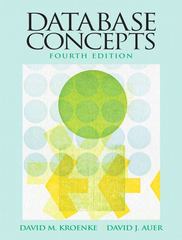Question
1. Suppose in a chat room, there is n number of people. Every person wants to communicate with every other person in the room.The policy
1. Suppose in a chat room, there is n number of people. Every person wants to communicate with every other person in the room.The policy of the chat room is to use encrypted message to communicate other people of this chat room.
o If they are using symmetric key, how many symmetric keys will be needed for n number of people
o If they are using asymmetric key, how many asymmetric keys will be needed for n number of people
2. In this problem, we will compare the security services that are provided by digital signatures (DS) and message authentication codes (MAC). We assume that Oscar is able to observe all messages sent from Alice to Bob and vice versa. Oscar has no knowledge of any keys but the public one in case of DS. State whether and how (i) DS and (ii) MAC protect against each attack. The value auth(x) is computed with a DS or a MAC algorithm, respectively.
1. (Message integrity) Alice sends a message x = Transfer $1000 to Mark in the clear and also sends auth(x) to Bob. Oscar intercepts the message and replaces Mark with Oscar. Will Bob detect this?
2. (Replay) Alice sends a message x = Transfer $1000 to Oscar in the clear and also sends auth(x) to Bob. Oscar observes the message and signature and sends them 100 times to Bob. Will Bob detect this?
3. (Sender authentication with cheating the third party) Oscar claims that he sent some message x with a valid auth(x) to Bob but Alice claims the same. Can Bob clear the question in either case?
4. (Authentication with Bob cheating) Bob claims that he received a message x with a valid signature auth(x) from Alice (e.g., Transfer $1000 from Alice to Bob) but Alice claims she has never sent it. Can Alice clear this question in either case?
1. It was stated that the inclusion of the salt in the UNIX password scheme increases the difficulty of guessing by a factor of 4096. But the salt is stored in plaintext in the same entry as the corresponding ciphertext password. Therefore, those two characters are known to the attacker and need not be guessed. Why is it asserted that the salt increases security?
2. Assuming that you have successfully answered the preceding problem and understand the significance of the salt, here is another question. Wouldnt it be possible to thwart completely all password crackers by dramatically increasing the salt size to, say, 24 or 48 bits?
3. Assume that passwords are limited to the use of the 100 printable ASCII characters and that all passwords are 10 characters in length. Assume a password cracker with an encryption rate of 6.4 million encryptions per second. How long will it take to test exhaustively all possible passwords on a UNIX system?
Step by Step Solution
There are 3 Steps involved in it
Step: 1

Get Instant Access to Expert-Tailored Solutions
See step-by-step solutions with expert insights and AI powered tools for academic success
Step: 2

Step: 3

Ace Your Homework with AI
Get the answers you need in no time with our AI-driven, step-by-step assistance
Get Started


